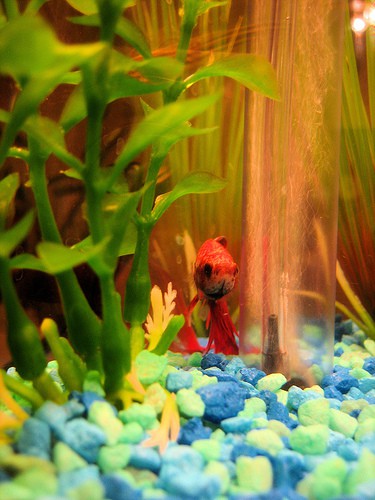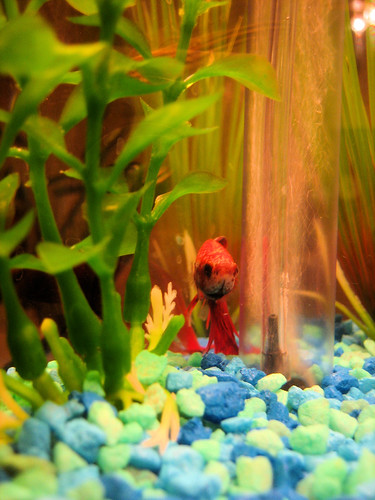Q: ZJ Wrote:
What kind of aquarium substrate do you recommend for a 2 gallon Betta tank?
A: Choosing the appropriate aquarium substrate for your tank is an important decision. First, I define aquarium substrate as the material(s) used to create the bed or floor of the aquarium. There are a variety of options available to suit many different needs and visual preferences.
I tend to break aquarium substrate down into two categories of which we select from each.
Category 1: Aesthetic
The aesthetic of the substrate is how we like it to look. Typically we either want a natural looking environment or an artificial looking one. Neither is better than the other per-se; it just comes down to personal preference. If you want a natural-looking aquarium you may select rock, sand or natural gravel for the substrate. For a more manufactured look you may choose marbles, glass beads or brightly colored gravel. It simply depends on the look you are trying to achieve.
Category 2: Particle Size
The size and general shape of the particles can have an impact on how the aquarium functions and while personal preference may play a roll here, it’s important to understand how the material you choose will effect the entire ecosystem.
If you have read my articles about tank cycling you know the important roll beneficial bacteria plays in your Betta tank. These healthy bacteria attach themselves to your filter material primarily as well as all surfaces in your tank including the substrate, plants and other decorations. The more surface area your substrate has, the more space you provide for this good bacteria to grow. This bacteria will thrive best on finer particles like coarse rock, small gravel or sand.
If you don’t intend to cycle your aquarium and instead choose to perform 100% water changes each week you may find it much easier to use larger materials like river stones or smooth materials like glass or polished stones. The larger substrate can be easily removed for cleaning or debris can be syphoned quickly from the space between the particulates.
Aquarium gravel, the most popular choice for aquarium substrate, falls in the middle. It offers a lot of surface area for nitrifying bacteria but can also be easily syphoned with a standard aquarium vacuum. It also comes in a variety of styles including black, natural stone, white and a variety of colors including neon.
Other Considerations
You may also want to consider how you intend to decorate your aquarium. Live plants, for example, may require a specific type of substrate to thrive. Many do best in natural sand or very fine gravel. While silk plants don’t need to extract nutrients from the soil, they will need something to hold them in place just the same. Smooth pebbles, marbles or large rocks may not hold them. Visually too, natural plants will look nicer with natural substrate just as your Sponge Bob Pineapple fish house may work better with a fun colorful gravel.
Whether you’re setting up your first Betta tank or doing a little remodeling, take a few moments to think about the look you are trying to achieve as well as how your aquarium functions. Decorating your tank can be a lot of fun and selecting the right substrate makes all the difference.



View Comments (6)
What is the smallest tank size one can use for a betta? I received a a 54 oz. betta tank as a gift but don’t really feel like that’s adequate. My mother keeps her’s in a 2 gallon and he seems like a happy camper in that size but 54 oz.? Not so sure…
Betta Care 101When selecting a substrate, be sure to consider whether or not you’re going to add live plants in the future.
i thought 100% changes should be avoided as it could cause the fish some shock because of a total and sudden change in water chemistry… right? if i'm wrong, please do inform me, okay? smiles…
Sometimes, you have to do a complete water change.
In such circumstance, I have found that the complete change of water should be done by measuring the temperature and PH of both the old water and the new water, then match the temperature and PH of the old to the new water before adding the new water to your tank.
The temperature can be manipulated by ice or hot tap water in a container (not in the tank) and the PH should be stabilized with a buffer after you get the temperature right, and before adding to the tank (without a buffer, PH “shoots” way up or down and kills fish).
I also follow these steps when doing a partial water change. I have never had problems with water change or stressed fish when using this method.
I have been using Sea-Chem Neutral Regulator with Sea-Chem Discus Buffer for years and I highly recommend it.
You can also buy aerobic bacteria to bring your tank into cycle and make it ready for fish.
This is great when you have to medicate and change all of your filtration media.
I hope this was helpful. Smiles. :)
For breeding purposes of Bettas:
Does having loose flat stone with gaps between hamper the male Betta from picking up the eggs that fall to the bottom? If so, what is the best substrate?
i’m looking into getting a 8 gallon Biorb Aquarium and was wondering what your views are on so much space? I currently have a 1.5 gallon tank but i would like to slowly add more fish into the picture, if my fish can handle sharing a tank with a few more creatures. he’s currently alone but my main question being is, is 8 galloons too much? I’ve read a few places that they enjoy shallow waters? .. 8 gallons is shallow compared to whats out there .. right?